| Photojournal
- 25 August 2006
San Josef Beach
On the 25th I again woke up in Port McNeill. This day was unlike the previous two in that I had no set plans for something to do. I debated just relaxing around the motel and doing some reading, but after (late) breakfast I found myself driving around with my camera. I decided to head west, and see if I could find the west coast of the island, or maybe go to Cape Scott Park, which occupies the northern tip.
From Port McNeill, I got on the road to Holberg. Soon I found myself facing a sign that I had never encountered. It seems like it was telling me that the road was about to turn white with black speckles. |
|
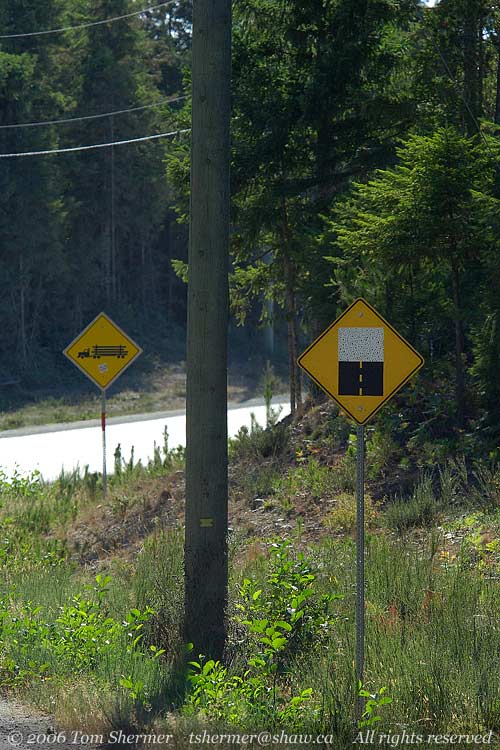 |
Well, really it was telling me that the road was about to turn into a gravel road. And the sign in back was telling me that there would be logging trucks zooming down this gravel road.
Always up for minor adventure, and trusting my little Honda, I forged on. It turned out that this wasn't a dirt road with a light dusting of gravel on it, but rather a road that was several centimeters deep in gravel. Driving on it was a different experience that other driving I've done, as the car didn't really hold turns very well..it would slide quite a bit in the loose gravel. This made my driving an interesting balance between going fast, and possibly sliding all around (hopefully not into the path of an oncoming logging truck), and going slow, possibly never making it to Holberg or beyond.
I saw very little traffic, though, and so gradually my speed increased as the journey wore on. I didn't check when I started, but I'd guess it took about an hour and a half to get to Holberg.
Holberg was a very small town with, as far as I could tell, one restaurant, which was an English pub-type thing. I stopped in and had lunch. The pub has a deck that looks out over the inlet that the town is on. |
|
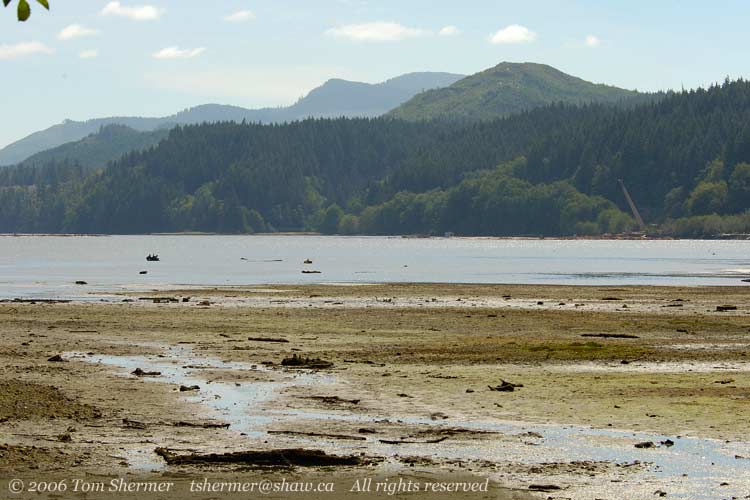 |
The tide seemed to be out, and there was a lot of mudflat near where I was. This inlet (called, appropriately enough, the Holberg Inlet) goes southeast from Holberg, but then connects to a channel that heads due west and reaches the Pacific at Quatsino Sound.
One of the neat things about Holberg was that the roads there were a little oasis of pavement surrounded by the deep gravel roads. I guess that arrangement would've been more common in years past, but in my rambles I've found that even the most tiny of the teeny-tiny places I've seen have been connected to the great maze of tarmac. So it was a surprise to find pavement out there past the gravel.
After lunch, I pushed westward, back into the gravel, with the goal of reaching a parking lot and trailhead that leads to Cape Scott Park and San Josef Beach. It took about 50 minutes to get there, but that included one wrong turn (the roads are not so well-marked). At the parking lot, I was greeted by a lone Stellar's Jay, who I chased around for a good ten or fifteen minutes before finally catching him in the clear and in the sunshine. |
|
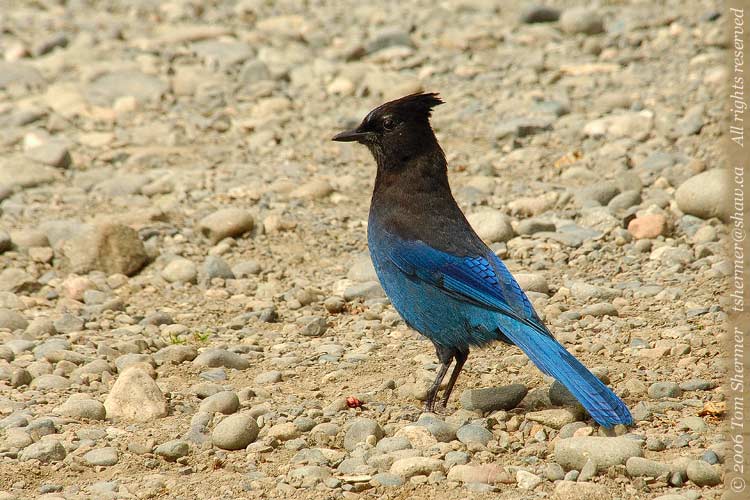 |
I love the colors on those jays.
I checked the information at the trailhead, and decided to first go to San Josef Beach, which was only a 2.5-kilometer walk away. The trail there was marked as wheelchair-accessible, even, which for me meant that it would be an easy walk rather than an up-and-down hike.
Back at the car, I hoisted my camera-equipment backpack onto my back, opted to leave the tripod behind, and then set out. The trail, as I had expected, was nice and flat and wide. The woods, or at least the canopy, was fairly thin, and a fair amount of sunlight could be found at ground level. |
|
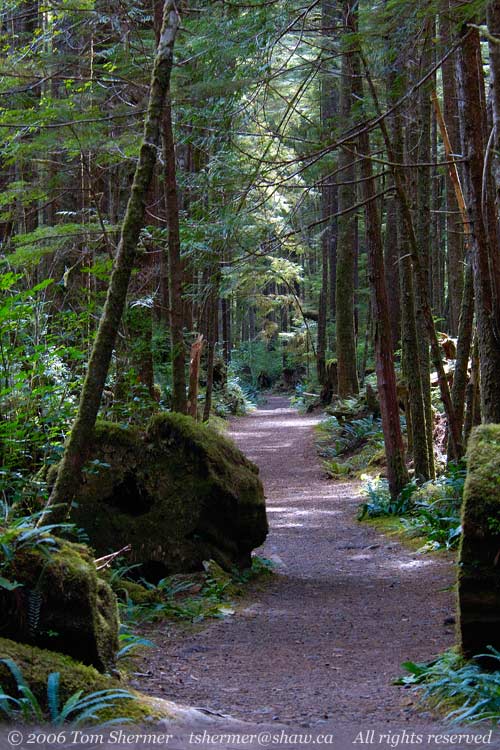 |
| I didn't notice much on the trail until I had been walking for about 45 minutes. It was a mixed day, with the sun sometimes behind clouds and sometimes out. Anyhow, the sun was out when I found a nice bit o' fungus growing out of the side of a tree. |
|
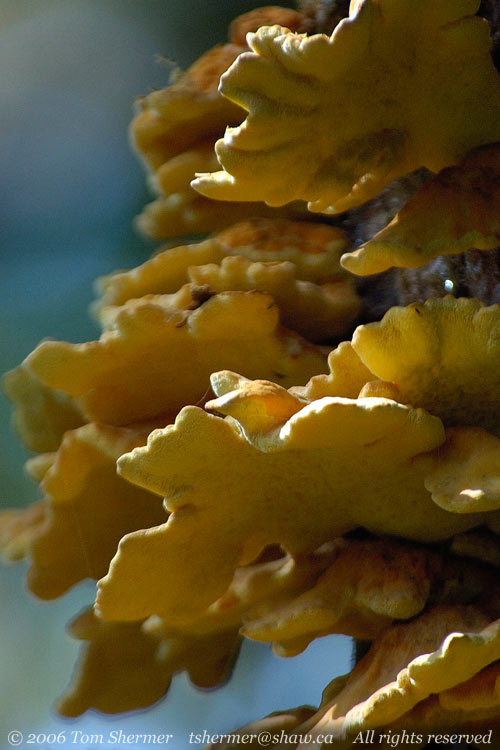 |
Not only a visual treat, that particular fungus is good eating, particularly when young. It's known as Sulfur Shelf, Sulfur Polypore, or Chicken Mushroom, the latter because it tastes a bit like chicken.
But I had recently had lunch and wasn't terribly hungry, so after a few pictures, I walked on.
But just a few minutes later I spotted a fly on a fern; this fly had some nice yellow coloration on his wings where they joined his thorax. Like I did with the jay a little earlier, I had to be patient to get a shot of this guy in sunlight. The parts of the woods that weren't directly lit were too dark to get a decent shot in. Besides which, the direct light really made this guy sparkle. |
|
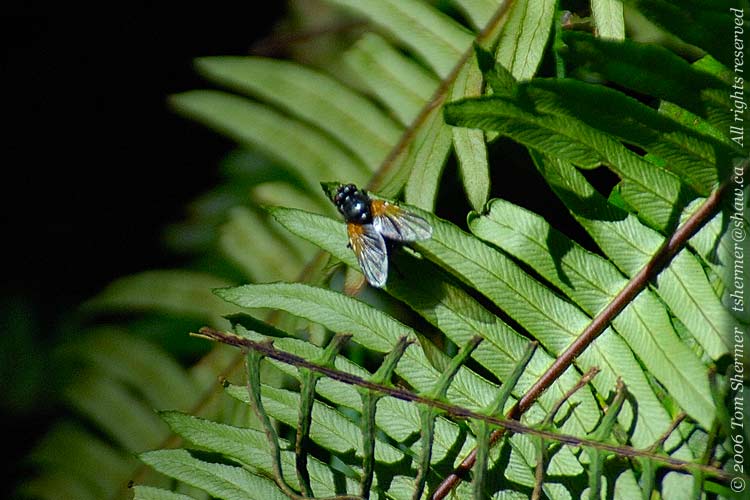 |
My best guess is that he's a Root Maggot Fly (a fly in the family Anthomyiidae).
Another 15 minutes past the fly, I found myself at San Josef Beach. The walk, including photography stops, had taken a little more than an hour.
The beach was a very nice affair, and I basically had it to myself. The people in the photo below left just a few minutes after this shot. Noone else came by for the rest of my visit. |
|
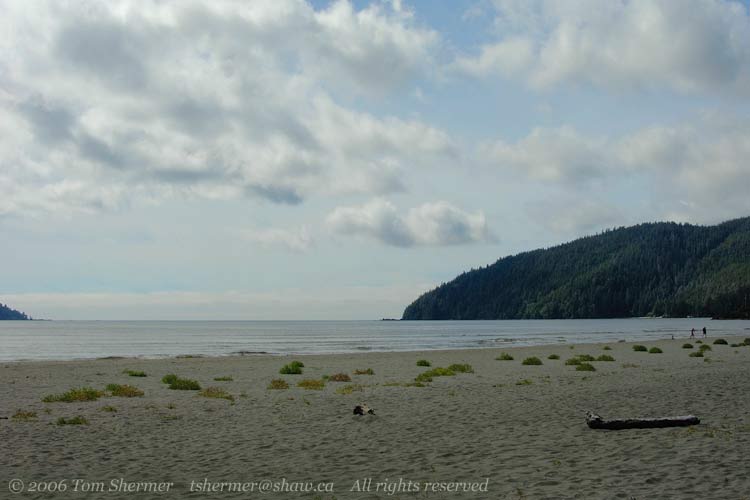 |
| As I had perceived from in the woods, the sun was playing hide-and-seek in the clouds. In the above photo, it was hidden, but a couple of minutes later, it was back out again. Here's the view of the beach to the left. |
|
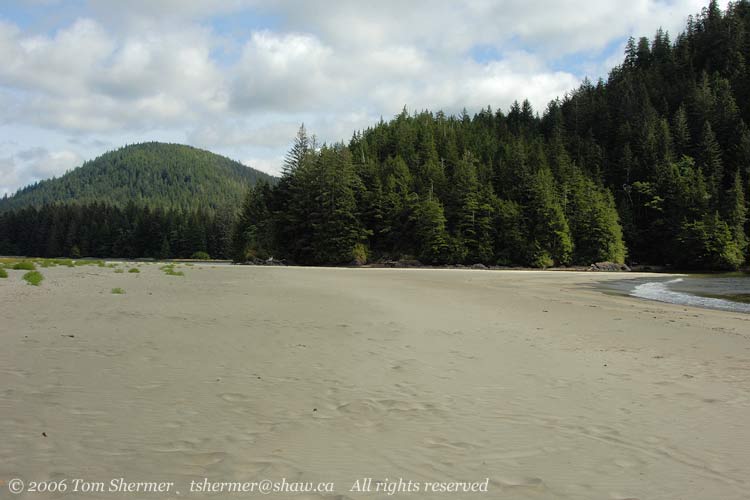 |
I headed that way, intending to go to the little knob of woods in the center of the photo. I didn't get there, though, because there was a channel of water between here and there, and it looked to be about knee-deep.
I got distracted by a few small birds flying by; they were obviously shorebirds and a quick check through my binoculars confirmed my suspicion that they were Semipalmated Plovers. I headed towards them to take some photos, but at about that point, the wind picked up a bit and they flew off.
I watched them fly for a while, shielding my face from the sand that was starting to blow up in the wind. Eventually they settled about 40 meters from where I was, roughly between me and the water. I walked a little closer and got this shot of them. |
|
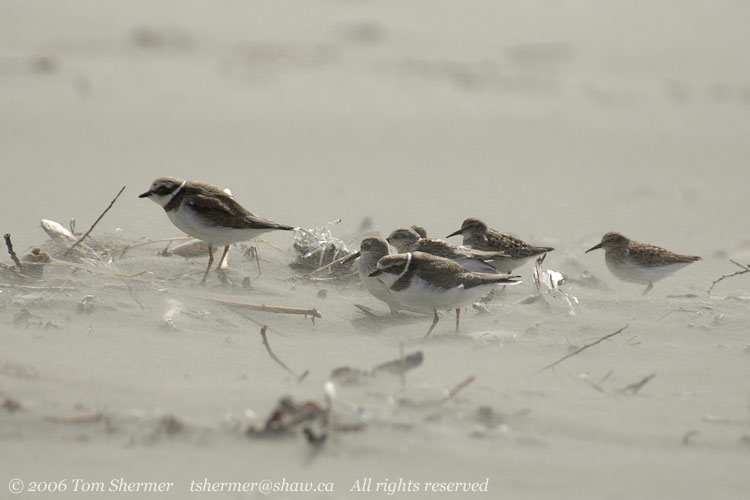 |
It turned out that the plovers had settled with a small flock of Western Sandpipers. In the above photo, the Westerns are the smaller birds, with the long pointed bill (like the rightmost bird), and the Semipalmateds are the bigger birds, with the short blunt bill (like the leftmost).
I had knelt in the sand to get that shot. With noone around to think I was crazy (or worse yet, to walk over to see what I was doing, thereby scaring the birds), and a little time on my hands, I decided to work on my bird-stalking. I see Western Sandpipers a lot in Vancouver, but don't see Semipalmated Plovers as much, and I thought it'd be a good opportunity to try to get good photos of them.
So, I divested myself of my backpack, got on my belly, and crawled like a worm. I kept my head pointed towards the birds, and my camera in front of my head. I rested the tripod mount of my lens on the sand keep the camera steady, and was able to get some good eye-level shots of the birds hunkering down in the wind. Here's a group of four Westerns. |
|
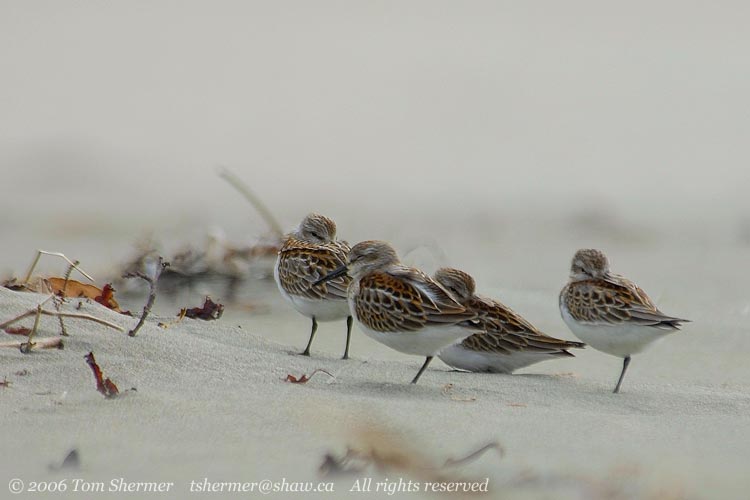 |
| And here's a mixed group. |
|
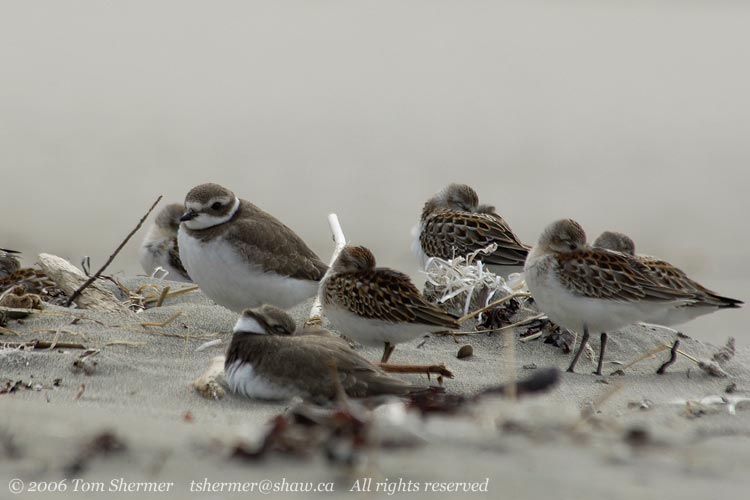 |
| Every now and then, I'd stop shooting and crawl a little forward, then set up again. I tried not to lift my head more than a couple of centimeters. |
|
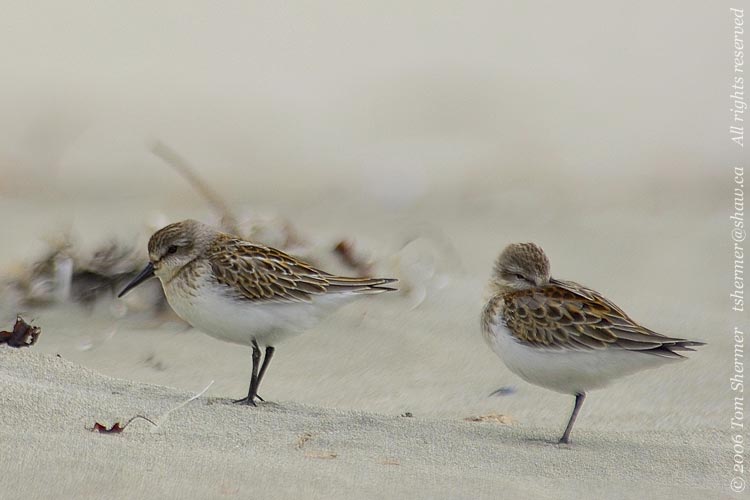 |
| In this next shot, I didn't have the camera straight up-and-down, so the whole world is a little tilted, but I ended up liking the effect. |
|
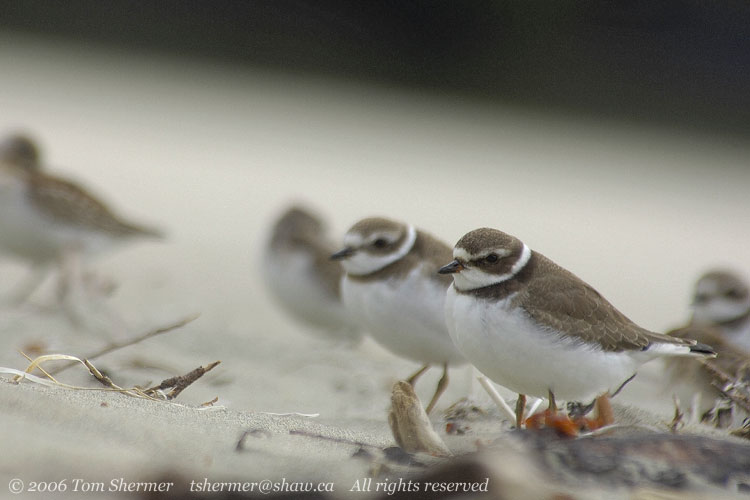 |
| Occasionally the wind would die down. |
|
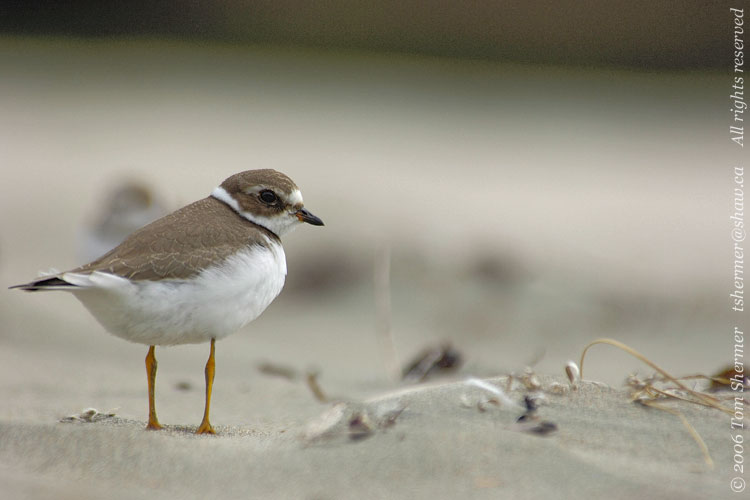 |
But most of the time it was blowing pretty hard, making life for both me and the birds pretty unpleasant. Sand was blowing into my face, into my clothes, into my binoculars, and, I hate to say, even a little into my lens. I should've had a cover around the camera and lens, but I was thinking about the birds and not the camera.
Here's a plover, leaning into the sandstorm. |
|
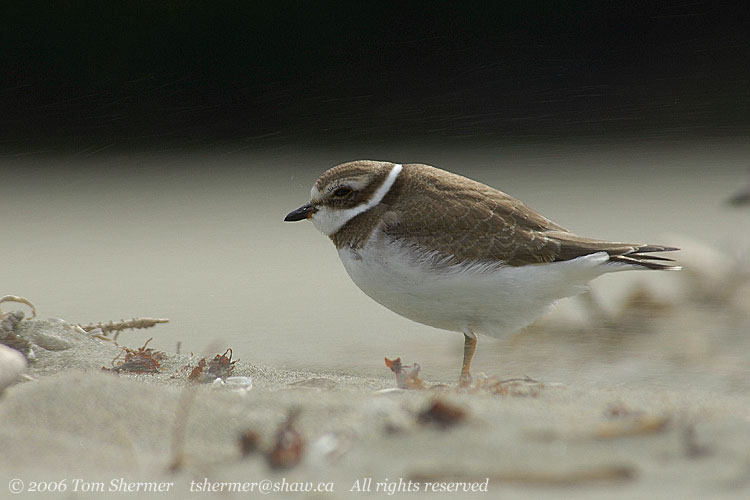 |
| My low profile in the sand let me get up quite close to the birds. The following photos are each cropped differently, but they give you an idea of how close I was able to get. My Sibley's lists these guys at 7.25 inches or 18.5 cm (from tip of bill to tip of tail). So on my monitor, at least, this photo is bigger than the bird. |
|
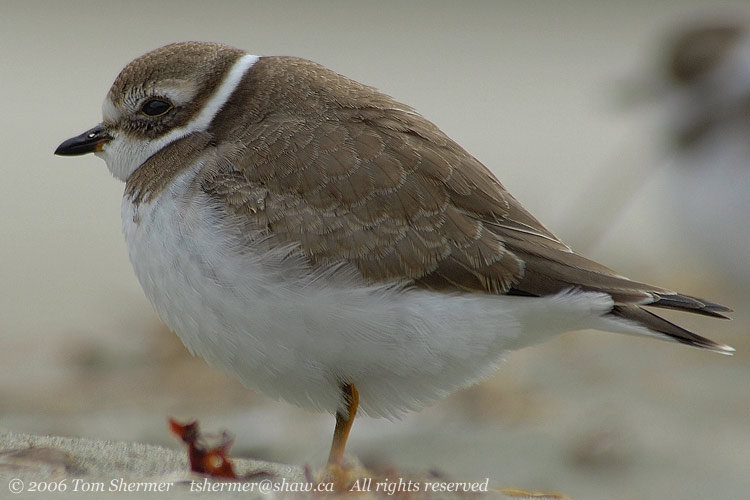 |
Anyhow, Semi Plovers are cute little birds, and I really enjoyed my time crawling around with them.
The plovers spent most of the time standing on one leg, which is supposedly a resting posture. I've done a bit of standing on one leg in my yoga classes, and have always found it fairly difficult; I don't think I could do it for more than a minute or two. But these little fellows were holding the posture for ten or fifteen minutes, even in the stiff wind, and appeared to be sleeping like that. (I wasn't close enough to hear them snore, so I couldn't really tell if they were faking the sleep thing or not.) |
|
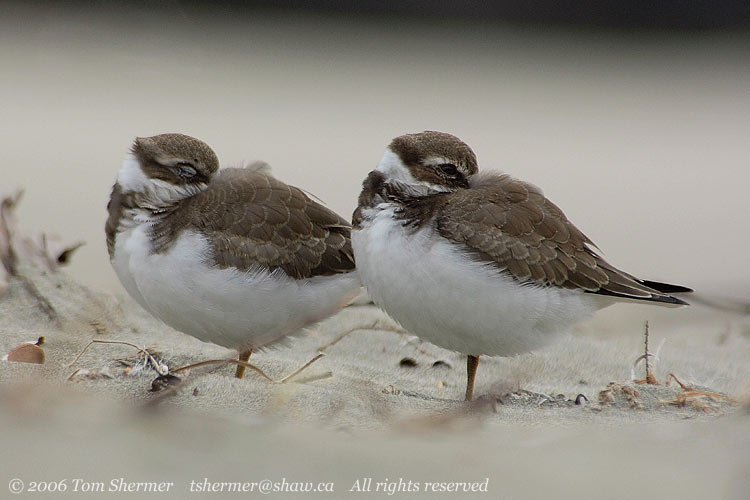 |
| Sleeping or no, the wind was really ruffling their feathers, as above, or on the left bird below. It takes a pretty strong wind to do that, but none of the little guys fell over, or wobbled, or had to steady themselves with their other leg. They were masters of balance and concentration. They had won my respect and admiration. I wished I was more like them. |
|
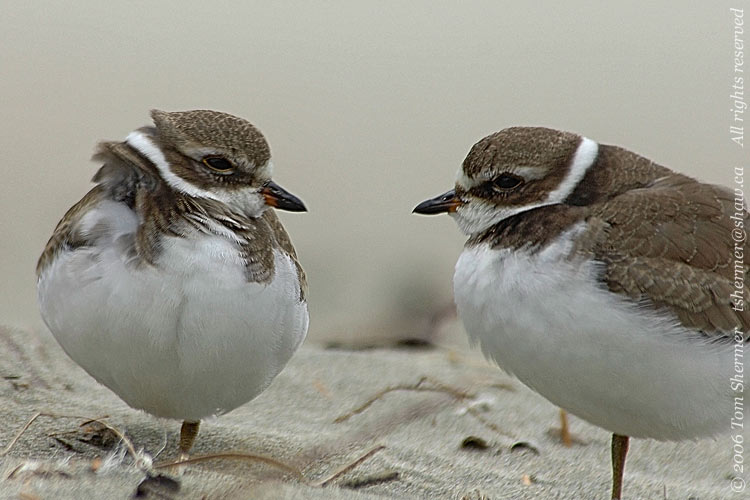 |
| The birds were certainly aware of me, but I guess I moved slowly enough and infrequently enough that they didn't get alarmed and run or fly away. I also didn't stare at them for the whole time, so they didn't always feel I was watching them: I spent about a half of the time with my head turned to the side and my camera pointed away. |
|
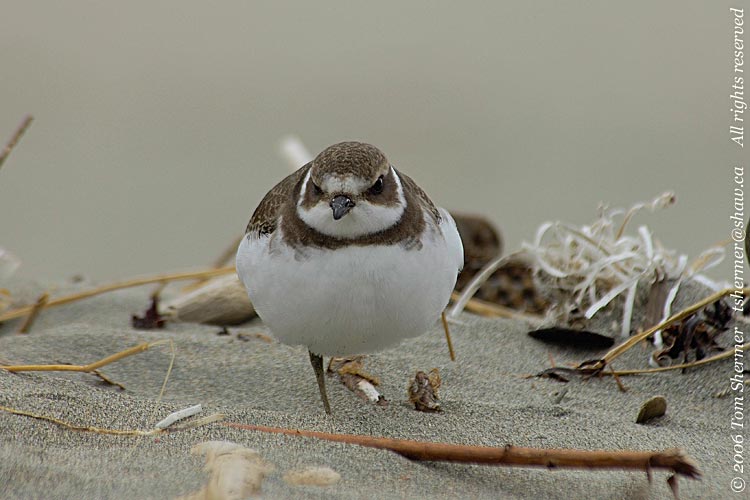 |
| I spent about an hour crawling and stalking in this manner. I moved twelve meters or so during that time, finally getting within about five meters of them. At that point, I was reaching their comfort zone, and they walked a little away whenever I moved closer. I knew I had some great photos in the can, so I figured that would be a good time to thank my little one-legged friends and back away. |
|
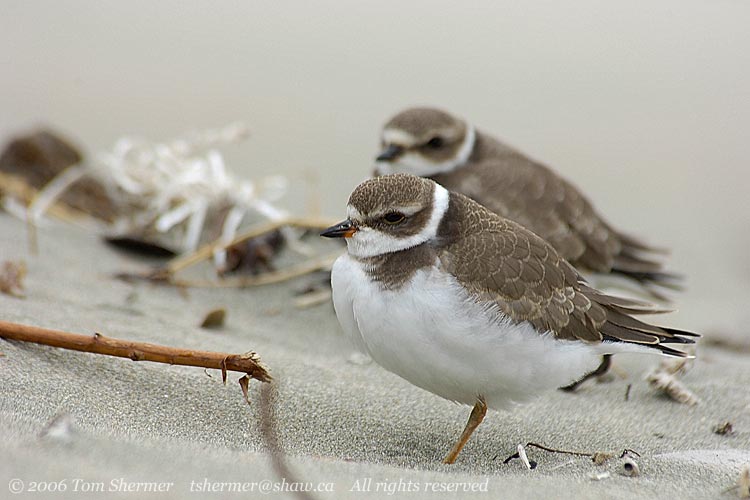 |
So that's what I did. They had been remarkably kind and tolerant, and an absolute pleasure to watch and get to know. I was quite happy with the experience, and even happier when I got to see the photos.
In retrospect, though, I should've taken more photos of the Western Sandpipers, because I was quite close to them, too. And I should've had my camera and binoculars protected from the blowing sand. The sand seems to no longer affect the zoom mechanism on my camera lens, but my binoculars still focus rough and will probably never recover from the ordeal. Live and learn, I guess.
As I walked back towards the trail, I became fascinated with the ripples that the blowing wind had left on the sand. The patterns they formed were fascinating, so I just had to take photos. For these shots, I put my wideangle lens on the camera (being careful to change the lenses inside the knapsack where the sand wasn't blowing around). |
|
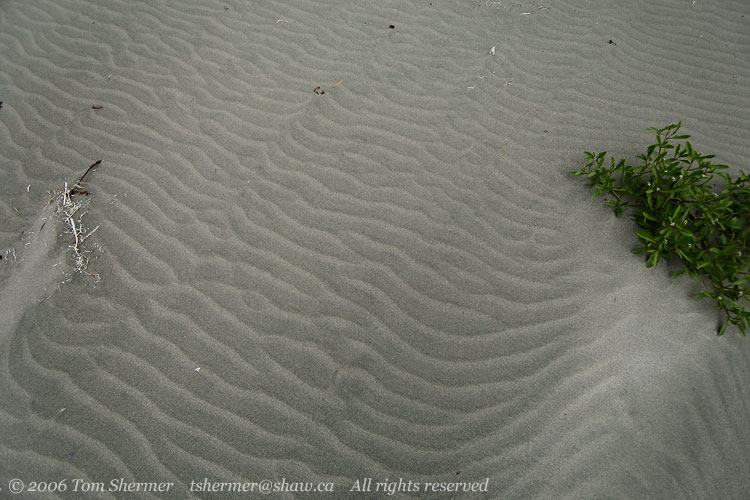 |
| I liked how little bits of beach stuff would affect the ripple patterns in different ways. |
|
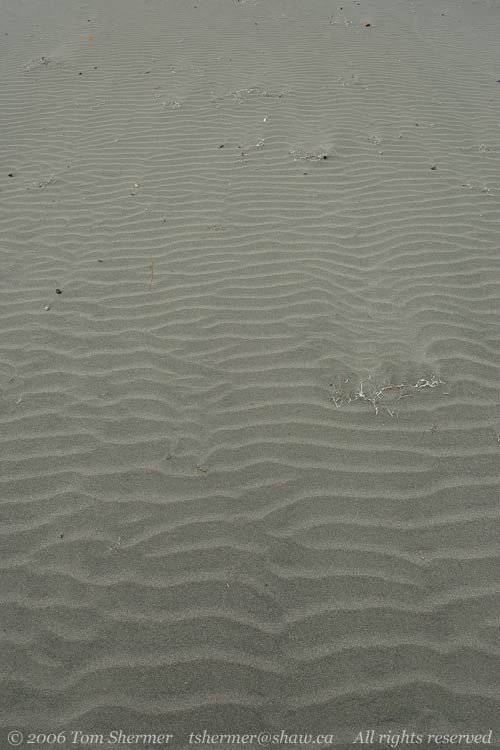 |
| These next two were taken with the camera pointed pretty much straight downwards. I had to take a very wide stance to avoid getting my feet in the shots. |
|
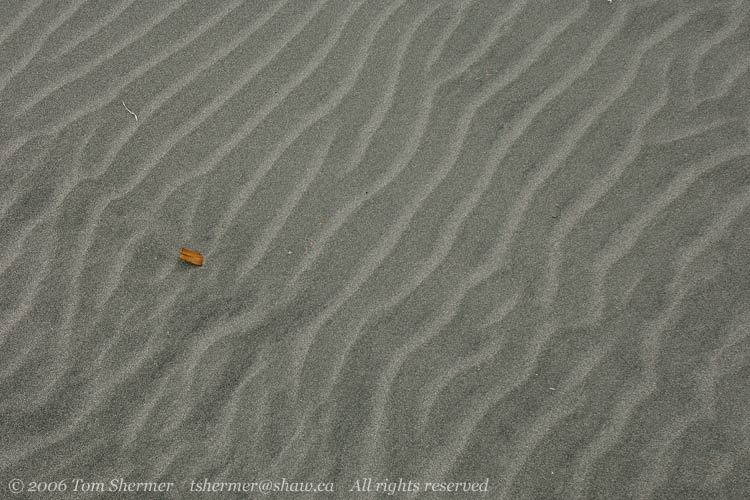 |
| |
|
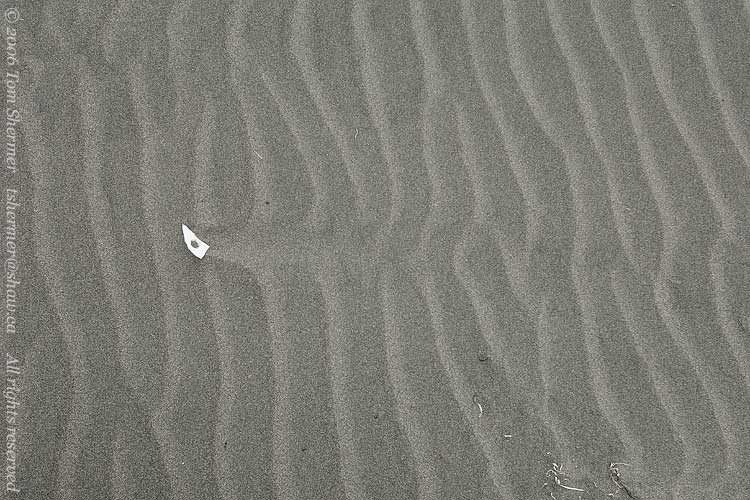 |
|
While I had been on my belly, the weather had changed from mix-of-sun-and-clouds to overcast. This next shot shows roughly how dark it had gotten. |
|
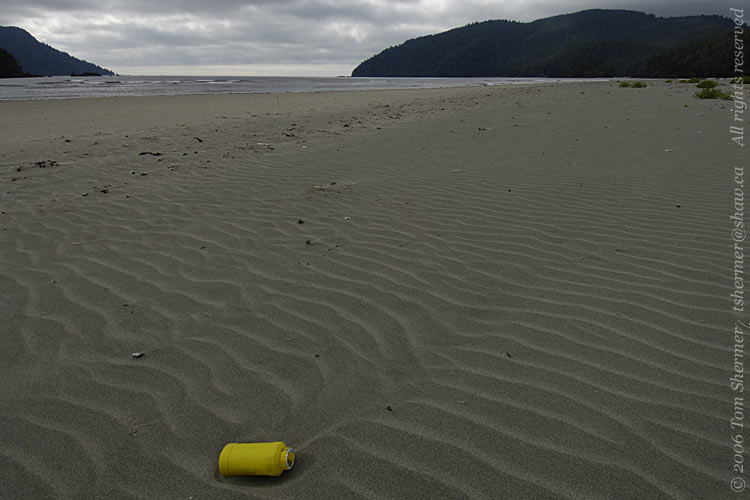 |
|
I took photos of one last subject on the beach, the root system of what appeared to be a driftwood stump that was near the trail entrance. |
|
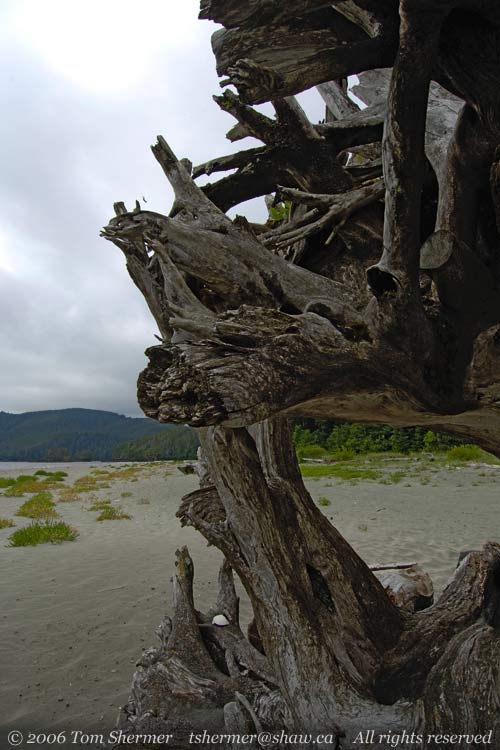 |
|
I decided not to head further along the trail, which paralleled the shore. I wasn't sure if the weather was going to turn rainy, or quite dark, or both. I didn't want to be out in the woods if it did. (Nor did I really wish to drive the gravel roads in bad conditions.) So I headed back towards my car, choosing a slightly faster pace than I had used on my walk out.
I paused to take some photos of piles of wood junk (both naturally fallen and cut) by the side of the trail. Things in the woods out here in BC get covered in green fairly quickly. |
|
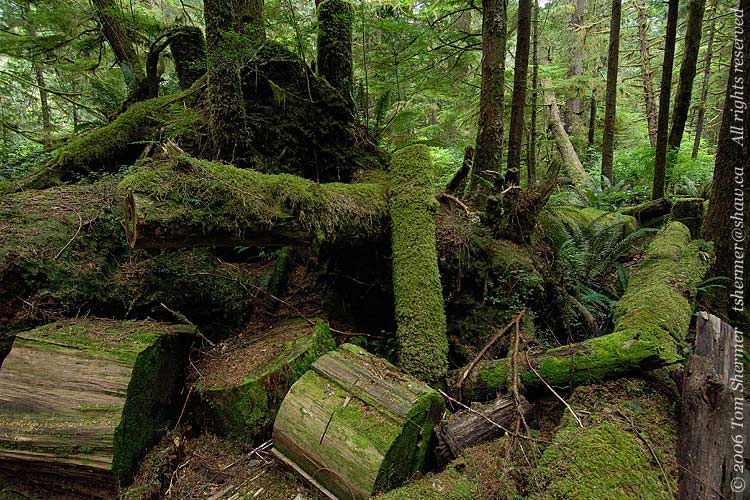 |
|
I spotted my Chicken Mushroom tree again soon thereafter, and couldn't resist a few more shots of it. |
|
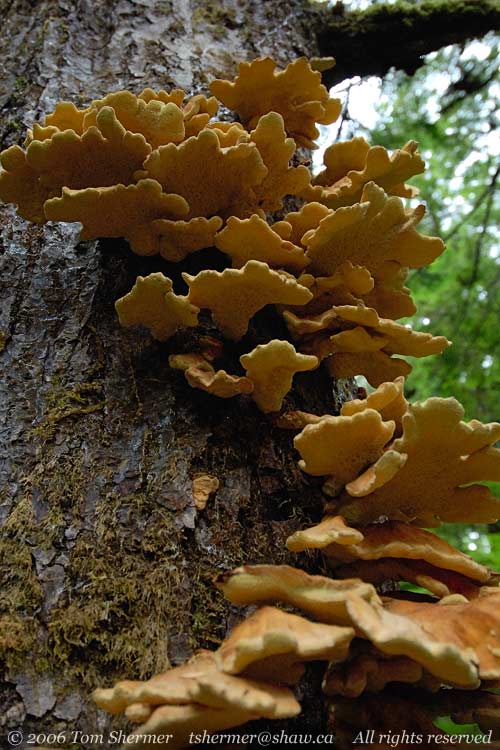 |
| At a few places, I stopped and took pictures of the trail and the surrounding woods. I still had the wideangle lens on the camera, and it was good for capturing the height of the trees. |
|
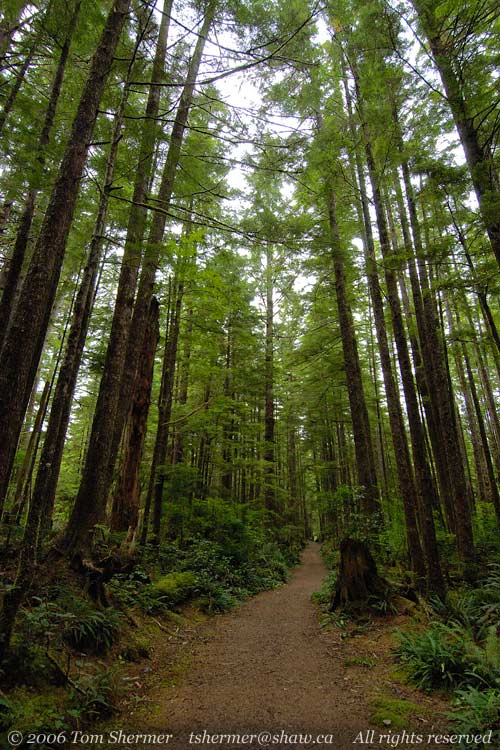 |
|
Here's one straight up a particularly gnarly tree that I liked. |
|
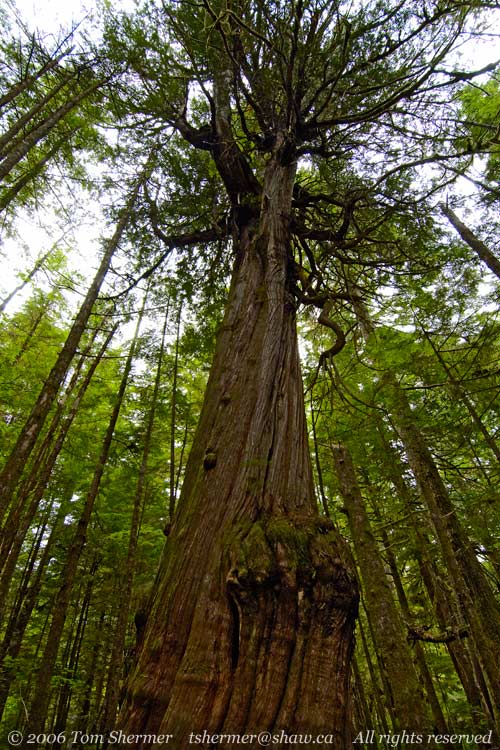 |
|
By the time I was back close to the car, the clouds had broken a little and I was able to see a bit of slightly-blue sky between the trees. |
|
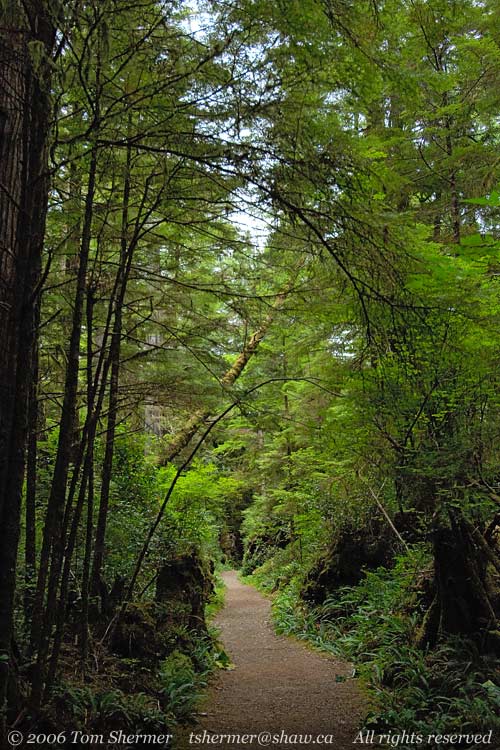 |
|
And that ended the photos that I took on my trip out to the west coast of the Island. I drove the gravel roads back to civilization, stopping in Holberg for gas, a soda, and a snack.
When I got back to the Island Highway, I turned north to Port Hardy rather than south to Port McNeill. There was some time left in the day, and I wanted to visit the north end of the highway.
This entry has gone on long enough, though, so the details of my visit to Port Hardy will have to wait until next time.
Doing my best worm imitation,
Tom |
|
|